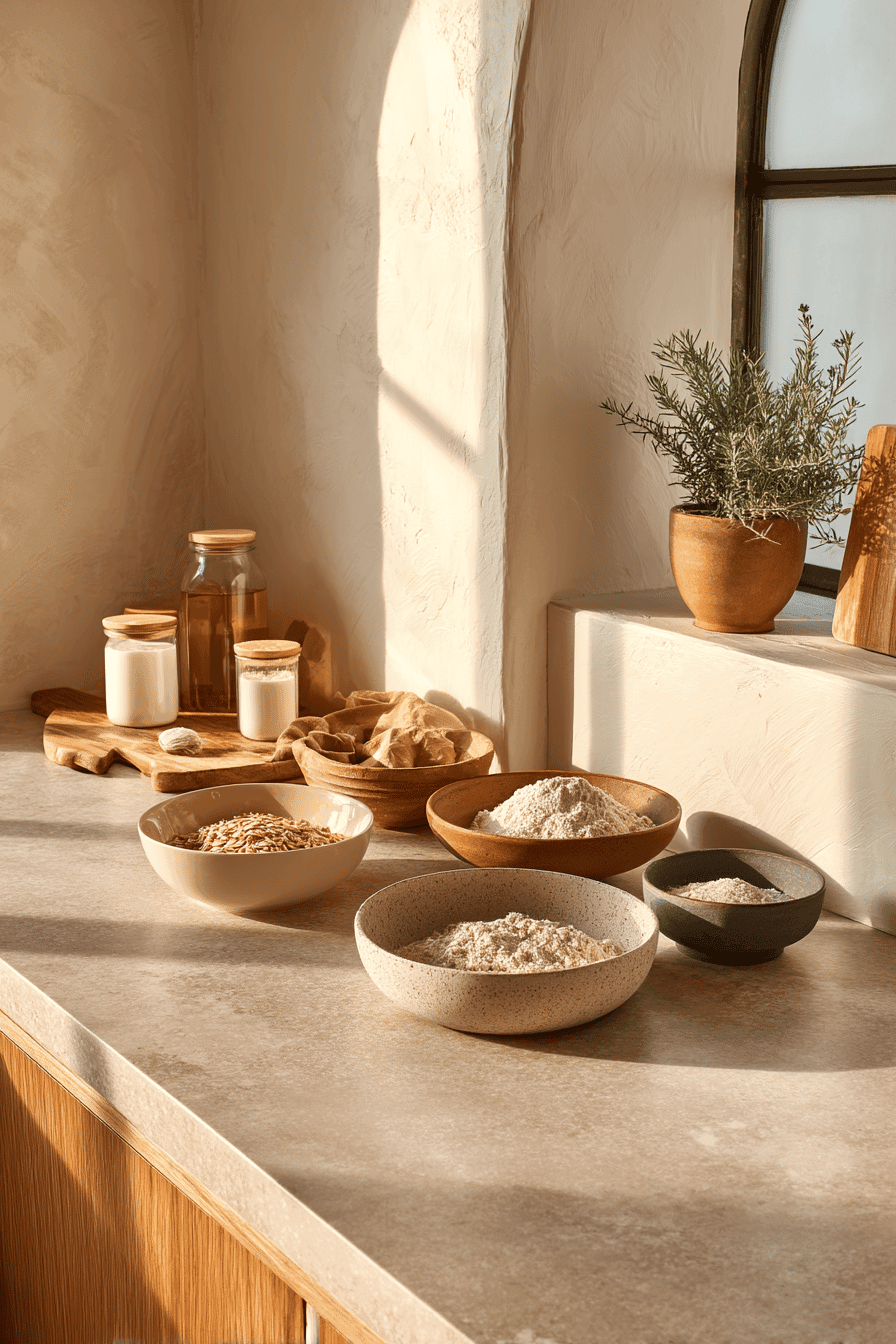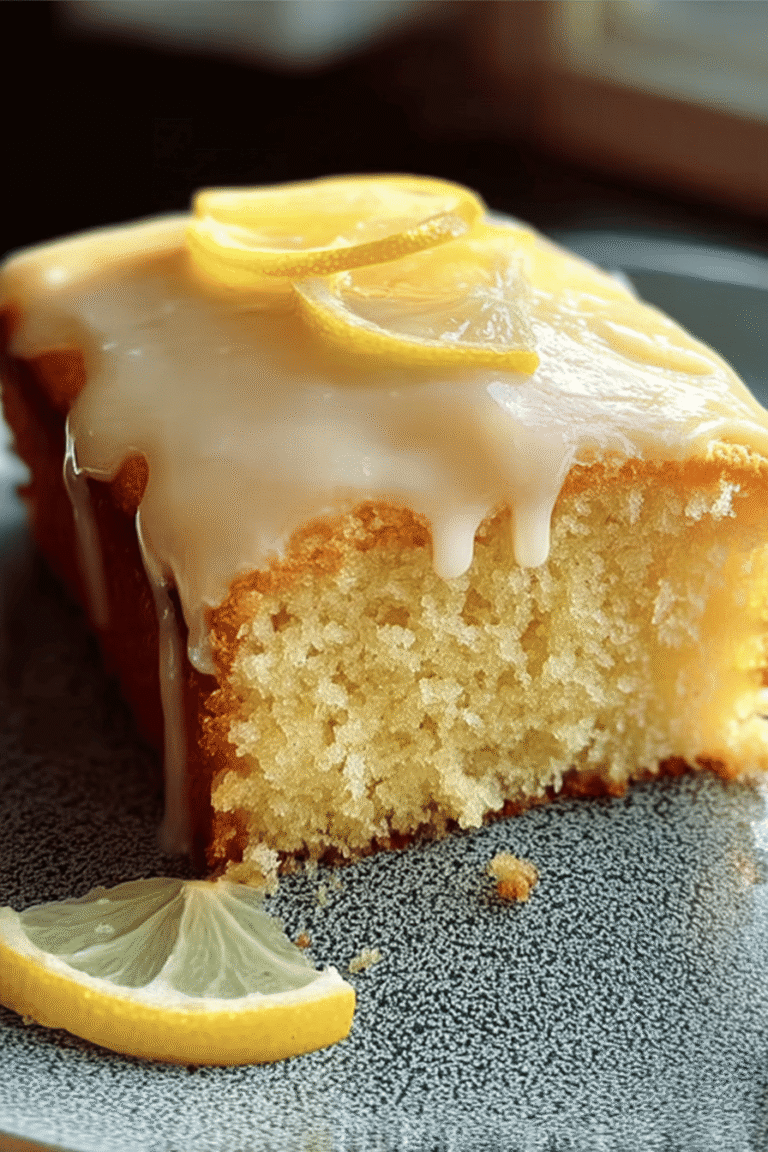Benefits and Advantages of lemon cake
This lemon cake recipe is particularly effective due to its ease of preparation, making it accessible even for beginner bakers. The straightforward steps and readily available ingredients ensure a smooth cooking experience. Health benefits are notable as this lemon cake can be adapted to include low-calorie and gluten-free options, catering to health-conscious individuals. The natural citrus flavor adds freshness without requiring excess sugar or artificial additives, allowing for a lighter dessert option.
The lemon cake stands out thanks to its balance of tartness and sweetness, appealing to a broad audience, and its versatility to fit various dietary needs enhances its appeal. Its moist texture and vibrant flavor make it a delightful treat that can be enjoyed on various occasions, from casual snacks to special celebrations.
Jump to:
- Benefits and Advantages of lemon cake
- Essential Ingredients for lemon cake
- Dietary Substitutions to Customize Your lemon cake
- How to Prepare the Perfect lemon cake: Step-by-Step Guide
- Mastering lemon cake: Advanced Tips and Variations
- How to Store lemon cake: Best Practices
- Nutritional Value of lemon cake
- FAQs: Frequently Asked Questions About lemon cake
- Can I bake this lemon cake recipe in different pan sizes or shapes?
- How do I make a buttermilk substitute for this lemon cake?
- What’s the best way to prevent the lemon cake from sticking to the pan?
- Can I store lemon cake with cream cheese frosting at room temperature?
- How can I increase the lemon flavor in the cake without using lemon extract?
- Moist and Soft Lemon Cake with Cream Cheese Frosting Recipe
- Ingredients
- Instructions
- Last Step:
- Notes
- Nutrition
- Did you make this recipe?
Essential Ingredients for lemon cake
- 3 cups (approximately 375 g) sifted all-purpose flour
- 2½ teaspoons baking powder
- ½ teaspoon baking soda
- ½ teaspoon salt
- 1 cup (16 tablespoons; 226 g) unsalted butter, softened
- ¼ cup (30 g) cornstarch (optional, to lighten texture)
- ¼ cup (60 g) unflavored vegetable or canola oil (optional, for moistness)
- 1⅜ cups (350 g) granulated sugar
- 3 to 4 large eggs, at room temperature
- 2 teaspoons pure vanilla extract
- 1 cup (240 ml) whole milk, at room temperature
- ⅓ cup (90 ml) fresh lemon juice (about 2 lemons)
- 1 heaping tablespoon lemon zest (about 2 lemons) or up to 3 tablespoons finely grated zest
- ½ cup (115 g) unflavored, unsweetened yogurt (optional, adds moisture and tartness)

Dietary Substitutions to Customize Your lemon cake
To accommodate different dietary needs, several substitutions can be made for this lemon cake recipe. For gluten-free baking, replace all-purpose flour with a certified gluten-free flour blend, which helps maintain a light and fluffy texture. Vegan variations can use flaxseed meal or applesauce as an egg substitute, combined with plant-based milk like soy or almond milk to keep moisture and structure intact.
Low-calorie options include using natural sweeteners such as stevia or erythritol instead of sugar, and swapping vegetable oil with unsweetened applesauce to reduce fat content while preserving moistness. Additionally, nut-free or soy-free adjustments can be made by opting for alternative ingredients that meet those dietary restrictions. These substitutions help maintain the lemon cake’s quality and flavor while catering to individual health and dietary preferences.
How to Prepare the Perfect lemon cake: Step-by-Step Guide
- Preheat and prepare pans: Preheat your oven to 350°F (177°C). Grease and line three 8- or 9-inch round cake pans with parchment paper to ensure easy removal.
- Mix dry ingredients: In a medium bowl, whisk together sifted all-purpose flour, cornstarch (if using), baking powder, baking soda, and salt. Set aside.
- Beat butter and sugar: In a large mixing bowl, beat softened butter (and oil if using) with granulated sugar on medium-high speed until light and creamy about 2 to 4 minutes scraping the bowl as needed.
- Add eggs and flavorings: Add eggs one at a time, beating well after each addition. Then mix in the vanilla extract, lemon zest, and lemon juice.
- Combine wet and dry ingredients: On low speed, alternately add the dry ingredients in thirds with milk (and yogurt if using), starting and ending with the dry ingredients. Mix until just combined to avoid overmixing; the batter should be thick and smooth.
- Fill pans and bake: Divide the batter evenly among the prepared pans. Bake for 21 to 33 minutes, or until a toothpick inserted into the center comes out clean or with a few moist crumbs, adjusting baking time as needed based on pan size and oven.
- Cool the cakes: Let the cakes cool in the pans for 15 to 20 minutes before transferring to wire racks to cool completely. Cooling may take approximately 1 hour.
Following these steps ensures a perfectly balanced, moist, and flavorful lemon cake suitable for various dietary needs. For detailed frosting instructions, consider exploring How to Make Cream Cheese Buttercream Frosting.

Mastering lemon cake: Advanced Tips and Variations
To achieve the best lemon cake, start with room temperature ingredients to promote even mixing and consistent texture. Adding a touch of vanilla extract or lemon extract enhances the citrus aroma, deepening the flavor without overpowering the delicate balance.
For texture interest, incorporate poppy seeds or slivered almonds into the batter to add a subtle crunch. Experiment with other citrus zest like lime or orange for a fresh twist on this classic dessert.
A richer experience can be created by finishing the cake with a lemon glaze or the classic cream cheese frosting, adjusting sweetness to your preference or dietary needs. When adapting for vegan or gluten-free versions, be mindful to adjust baking times and check moisture levels carefully to maintain softness and moistness.
Storing and reheating are also crucial; cool the cake completely before frosting and chill the assembled cake properly to retain texture and flavor.
These tips and variations enable bakers to personalize their lemon cake while honoring its bright, refreshing nature. For detailed instructions on ensuring moisture, see Tips for Baking Moist Lemon Cake.
How to Store lemon cake: Best Practices
Lemon cake with cream cheese frosting should be stored in the refrigerator inside an airtight container to preserve freshness and prevent drying out. At room temperature, unfrosted lemon cake can remain fresh for a couple of days when wrapped well.
For longer storage, wrap the cake tightly in plastic wrap, then foil, and freeze. Thaw it slowly in the fridge before serving for best moisture retention and flavor. Before slicing, allow the cake to come to room temperature to soften the frosting and enhance texture.
When reheating slices, use low heat in the oven or short bursts in the microwave to avoid drying out the cake. Proper storage ensures your lemon cake remains moist, tender, and delicious several days after baking.
Nutritional Value of lemon cake
| Nutrient | Approximate Amount per Serving |
|---|---|
| Calories | 300-380 kcal |
| Protein | 5-7 g |
| Fat | 15-20 g |
| Carbohydrates | 35-45 g |
| Sugar | 25-30 g |
| Cholesterol | 60-90 mg |
This lemon cake provides a balance of energy from carbohydrates and fats, alongside protein from eggs and dairy ingredients. The lemon juice and zest offer vitamin C, enhancing the nutritional profile and adding freshness without extra calories.
Using yogurt or substituting some butter with oil or applesauce can alter fat content and calories to fit various dietary needs. Understanding these values assists in portion control and ingredient modifications without sacrificing taste or texture.

FAQs: Frequently Asked Questions About lemon cake
Can I bake this lemon cake recipe in different pan sizes or shapes?
How do I make a buttermilk substitute for this lemon cake?
What’s the best way to prevent the lemon cake from sticking to the pan?
Can I store lemon cake with cream cheese frosting at room temperature?
How can I increase the lemon flavor in the cake without using lemon extract?

Moist and Soft Lemon Cake with Cream Cheese Frosting Recipe
🍋 Enjoy a burst of citrusy goodness with this moist and soft lemon cake, topped with a creamy cheese frosting!
🎂 Perfect for any celebration, the delightful flavors and homemade charm make it a must-try.
- Total Time: 4 hours
- Yield: 12 servings 1x
Ingredients
3 cups (375 g) sifted all-purpose flour
2½ teaspoons baking powder
½ teaspoon baking soda
½ teaspoon salt
1 cup (226 g) unsalted butter, softened
¾ cup (170 g) unsalted butter, room temperature
¼ cup (30 g) cornstarch (optional)
¼ cup (60 g) vegetable or canola oil (optional)
1¾ cups (350 g) granulated sugar
3 to 4 large eggs, at room temperature
2 teaspoons pure vanilla extract
1 cup (240 ml) whole milk, at room temperature
⅓ cup (90 ml) fresh lemon juice
1 tablespoon lemon zest
½ cup (115 g) unsweetened yogurt (optional)
Cream Cheese Buttercream Frosting:
1 cup (226 g) unsalted butter, softened
8 ounces (226 g) cream cheese, softened
4½ cups (540 g) confectioners’ sugar, sifted
2 tablespoons fresh lemon juice
1 teaspoon pure vanilla extract
Pinch of salt
Instructions
1. Preheat the oven to 350°F (177°C). Grease and line three 8- or 9-inch round cake pans with parchment paper.
2. Whisk together all-purpose flour, cornstarch, baking powder, baking soda, and salt; set aside.
3. In a large bowl, beat softened butter and sugar until creamy and light, about 2-4 minutes.
4. Add eggs one at a time, mixing well, then add vanilla, lemon zest, and juice.
5. On low speed, mix in dry ingredients alternately with milk, starting and ending with flour. Do not overmix.
6. Divide batter among pans, baking for 21-33 minutes or until a toothpick comes out clean.
7. Cool cakes in pans for 15-20 minutes, then transfer to wire racks to cool fully. Frost when completely cool.
Frosting Preparation:
1. Beat butter until creamy, add cream cheese, and blend until smooth.
2. Gradually add confectioners’ sugar, lemon juice, vanilla, and salt. Beat on high for 3 minutes until fluffy.
3. Frost cake between layers and around the sides evenly.
Assembly:
1. Level cakes if needed. Place one layer on a serving plate, spread frosting, and stack the next layer.
2. Frost the sides and top. Garnish if desired.
3. Refrigerate the cake for 30-45 minutes before slicing.
4. Store leftovers covered in the fridge for up to 5 days.
Last Step:
Please leave a rating and comment letting us know how you liked this recipe! This helps our business to thrive and continue providing free, high-quality recipes for you.Notes
🧊 Sift flour before measuring for a tender cake crumb.
🥛 Use whole milk for rich texture, but other milks alter results.
🍰 Bake layers a day in advance, cover, and chill for easy assembly.
- Prep Time: 30 minutes
- Cooling & Assembly: 2 hours
- Cook Time: 21-33 minutes per batch
- Category: Dessert
- Method: Baking
- Cuisine: American
- Diet: Vegetarian
Nutrition
- Serving Size: 1 slice
- Calories: 300-380
- Sugar: N/A
- Sodium: N/A
- Fat: N/A
- Saturated Fat: N/A
- Unsaturated Fat: N/A
- Trans Fat: N/A
- Carbohydrates: N/A
- Fiber: N/A
- Protein: N/A
- Cholesterol: N/A







